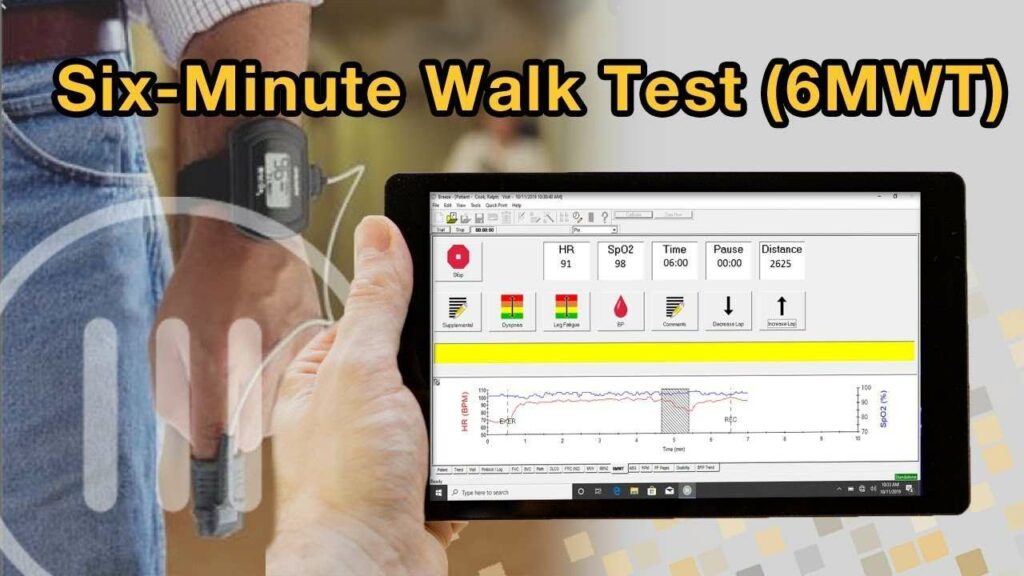Do you ever feel like you don’t have enough energy to get through the day? Are you always tired and find it hard to focus? If so, you may be suffering from a lack of stamina. Luckily, there is a simple test that can help you improve your energy levels. The 6-minute walk test(6mwt) is a great way to measure your stamina and see where you need to make improvements. In this blog post, we will discuss the benefits of the 6-minute walk test and how to perform it correctly.
Contents
- 1 What Is 6 Min Walk Test (6mwt)?
- 2 What Is the 6mwt score?
- 3 What Is The Purpose Of 6MWT?
- 4 How to Perform the 6mwt?
- 5 How to Increase Your Stamina with the 6-Minute Walk Test?
- 6 What Conditions Does It Assess?
- 7 Is 6 min walk Test Valid?
- 8 What Does the Test Result Mean?
- 9 Can 6mwt Be Done On a Treadmill?
- 10 Tips
- 11 Conclusion
What Is 6 Min Walk Test (6mwt)?

The 6MWT is a submaximal exercise test used to estimate the functional capacity and assess the effects of interventions on cardiorespiratory fitness. The 6MWT has also been used as an endpoint in clinical trials.
The six-minute walk test is a distance measurement of how much ground an individual can cover in six minutes on level, hard terrain. The objective is to see how far the person can walk within the time limit.
What Is the 6mwt score?
The six-minute walk test (6MWT) is a submaximal exercise test used to assess an individual’s functional status. The 6MWD provides a safe, easy way to evaluate someone’s response to therapy.
Most adults have a score of 400-700 m. However, some exceptions include age, sex, and health conditions.
If your risk score is above 5, your 5-year survival rate is 97%. For those with a score between 4 and -11, the 5-year survival rate drops to 90%. And if you happen to have a score below -11, your chances of surviving beyond five years fall to 65%. Out of all the high-risk patients studied, 74% had the occlusive coronary disease in three or more vessels.
What Is The Purpose Of 6MWT?
The purpose of 6 min walk test is as follows:
- To assess an individual’s functional exercise capacity
- To monitor changes in an individual’s functional exercise capacity over time
- To help guide decisions about an individual’s level of activity and appropriate intensity of walking programs
How to Perform the 6mwt?

You will be asked to walk at your own pace for six minutes. A heart rate monitor will be placed on your finger or earlobe to measure your heart rate, and you will be given a light portable oxygen tank to wear if you have COPD or another condition that requires supplemental oxygen.
You will be asked to walk back and forth along a level surface, such as a hallway or gymnasium, for six minutes. The test may be timed with a stopwatch, or you may be asked to complete as many laps as possible in six minutes.
During the Test
- Start by walking at your usual pace for 2 minutes.
- After 2 minutes, walk as fast as you can for the remaining 4 minutes.
- You may stop to rest if needed, but try to minimize the amount of time spent resting.
- The goal is to cover as much distance as possible in 6 minutes.
Post-Test
- Walk slowly for 5 to 10 minutes to cool down.
- Record the distance you covered to the nearest tenth of a mile or kilometer.
How to Increase Your Stamina with the 6-Minute Walk Test?
To increase your stamina with the 6-minute walk test, do the following:
- Walk at a fast pace for the full 6 minutes.
- If you need to rest, do so for as little time as possible.
- Gradually increase the distance you walk each time you take the test.
What Conditions Does It Assess?
It will commonly assess heart and lung conditions such as:
- Congestive heart failure (CHF)
- Chronic obstructive pulmonary disease (COPD)
- Emphysema
- Bronchitis
- Asthma
- Cystic fibrosis
- Interstitial lung disease
Is 6 min walk Test Valid?
The six-minute walk test (6MWT) is a submaximal exercise test used to estimate the functional capacity and cardiorespiratory endurance. The 6MWT has been shown to be a reliable, valid, and responsive measure in a variety of populations.
The 6MWT is simple to administer and requires minimal equipment. The test can be completed in a relatively short period of time, making it an efficient tool for clinicians.
The 6MWT is safe and well-tolerated by most people. There is a low risk of serious adverse events associated with the test.
It is a useful tool for assessing functional capacity and cardiorespiratory endurance. The test can be used to monitor changes in functional status over time and to compare the functional capacity of different groups of people.
What Does the Test Result Mean?
The 6-minute walk test is used to measure how far you can walk in six minutes and how this distance compares to what is considered normal for your age, sex, and height. The test is also used to monitor your response to treatments for conditions that affect your ability to walk, such as COPD.
A typical goal for the 6-minute walk test is to increase the distance walked by at least 10 percent. This may not sound like much, but it can make a big difference in your daily life.
The distance you are able to walk in six minutes is directly related to your functional capacity. Functional capacity is a measure of the amount of work your body can do and is an important predictor of mortality.
A higher functional capacity indicates a lower risk of death from all causes. The 6-minute walk test can be used to monitor your functional capacity over time and to compare it to the functional capacity of other people.
Can 6mwt Be Done On a Treadmill?
The six-minute walk test is commonly used to measure functional capacity in patients with lung disease. This test can also be performed on a treadmill, which may be easier for some patients.
If you have lung disease, you may find it difficult to walk even short distances. The six-minute walk test (6MWT) is a way to measure how well your lungs are working and how much exercise capacity you have.
The test is simple: you walk as far as you can in six minutes. The distance you walk is a good indicator of your overall lung function and fitness level.
You may have to stop before the six minutes are up if you feel too short of breath, but that’s okay.
Tips
The 6-minute walk test is a simple and easy way to measure your aerobic fitness. All you need is a stopwatch and a flat, level surface.
- Walking is an excellent way to improve your aerobic fitness, and the 6-minute walk test is a great way to gauge your progress. Here are some tips to help you make the most of the test.
- Wear comfortable shoes and clothing. You want to be able to move freely and not be distracted by your clothes during the test.
- Warm up before the test. A light 5-10 minute walk will help get your muscles loose and warm.
- Walk at a pace that is challenging but manageable. You want to push yourself, but you don’t want to burn out before the end of the test.
- Focus on your breathing. Taking deep, regular breaths will help you maintain your pace and prevent you from getting too winded.
- Cool down after the test. A light walk or stretch will help your muscles recover.
The 6-minute walk test is a great way to assess your aerobic fitness and see how you’re progressing. By following these tips, you can make sure you get the most out of the test.
Conclusion
It may be concluded that the 6min walk test( 6MWT) is a simple, feasible and reproducible measure of functional exercise capacity in patients with COPD. The results of 6MWT can improve our ability to predict mortality and morbidity in these patients. The test is also responsive to changes in disease severity and therapy. Furthermore, the 6MWT is a safe and well-tolerated test in patients with COPD.
The 6MWT is a standardized, sub-maximal exercise test that assesses functional exercise capacity in terms of the distance an individual can walk over 6 minutes. The test is easy to administer and requires minimal equipment. It is also safe and well-tolerated in patients with COPD.
Physical Therapy help patients recover from pain. If you’re experiencing Back pain, Shoulder pain, Knee pain, Neck pain, Elbow pain, Hip pain, or Arthritis pain, a physical therapist at MantraCare can help: Book a physiotherapy session.


